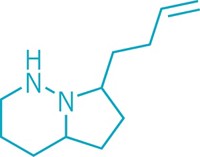Advertisement
Grab your lab coat. Let's get started
Welcome!
Welcome!
Create an account below to get 6 C&EN articles per month, receive newsletters and more - all free.
It seems this is your first time logging in online. Please enter the following information to continue.
As an ACS member you automatically get access to this site. All we need is few more details to create your reading experience.
Not you? Sign in with a different account.
Not you? Sign in with a different account.
ERROR 1
ERROR 1
ERROR 2
ERROR 2
ERROR 2
ERROR 2
ERROR 2
Password and Confirm password must match.
If you have an ACS member number, please enter it here so we can link this account to your membership. (optional)
ERROR 2
ACS values your privacy. By submitting your information, you are gaining access to C&EN and subscribing to our weekly newsletter. We use the information you provide to make your reading experience better, and we will never sell your data to third party members.
Art & Artifacts
Newscripts
Chemistry and materials science in vogue
by Ariana Remmel
April 23, 2023
| A version of this story appeared in
Volume 101, Issue 13
Couture in a can

The semiannual Paris Fashion Week attracts fashionistas from around the world to see—and be seen in—the latest trends. Yet one viral moment from September 2022 during the spring/summer edition of the event had even seasoned veterans stunned. In the finale of fashion brand Coperni’s runway show, celebrity supermodel Bella Hadid stood before the audience almost completely nude. The spectacle quickly went from risqué to bizarre when black-clad stage assistants began airbrushing Hadid in white liquid. The material seemed to cling and solidify on her bare skin until Hadid appeared draped in sleek, white fabric. Before the audience’s eyes, the model went from wearing nothing but her birthday suit to an avant-garde gown in minutes. Clips of the transformation quickly went viral on social media.
The Coperni spray-on dress was made possible by Fabrican, a fabric in a can developed by Spanish fashion designer Manel Torres. Nicknamed the Chemist Tailor, Torres initially conceived of the material while collaborating with the Chemical Engineering Department at Imperial College London. At the time, he was a doctoral student studying fashion at the Royal College of Art. He founded the company Fabrican in 2003 to develop the technology further.
Fabrican starts as a suspended mélange of synthetic and natural fibers made from a proprietary formula. This mixture can be deposited directly onto skin with a paint sprayer or aerosol can. As the fibers are sprayed onto the desired surface, they cross-link with one another to form an instant, nonwoven fabric, according to the Fabrican website. “The Spray-on fabric technology ties in with concerns around sustainability in the fashion industry, since the material can be washed, reused and finally, when the garment has come to the end of its use, dissolved for re-spraying,” the website says.
This isn’t the first time that Fabrican has made an appearance on the runway, but Hadid’s sensational spray-on dress brought renewed attention to the versatility of canned textiles. “Things went really smoothly. I hope that now, the world has seen the capabilities of this fabric in full effect and that more fashion brands will take the same route,” Torres told Complex magazine in October about the viral moment. Perhaps one day, spray-on fabrics could have such far-reaching applications as custom upholstery or bespoke personal protective equipment.
A light touch does the trick

Attendees of the fall/winter 2023 edition of Paris Fashion Week were in for their own magic show when Japanese fashion designer Kunihiko Morinaga presented the latest collection for his brand, Anrealage, in February. At first, models walked in pairs onto a darkened stage; they were dressed in couture garments constructed from intricate patchworks of faux fur, satin, lace, and other luxurious textiles. The collection looked to be fashioned all in white—but only at first.
After an initial parade of pallid ensembles were presented before a mostly silent audience, two ultraviolet light strips descended to center stage. The light bars appeared to scan each model head to toe, front then back. Where the light touched, the fabrics transformed from bright white to a spectrum of lively pastels—and the crowd went wild. “This is an Anrealage coup de théâtre that never gets old,” Luke Leitch wrote in Vogue in February. Color-morphing fabrics are part of the signature style that Morinaga brings to the brand, which has also featured monochrome garments that reveal prismatic patterns when they reflect the light from a camera flash. But the latest collection from Anrealage debuted new “photochromic hardware” that expands the kinds of textiles and colors that Morinaga can incorporate into his creations, Leitch wrote. It’s difficult to find details about the mechanism underpinning this chameleon technology, a mystery that only adds to the enchantment of Morinaga’s creative vision.
Please send comments and suggestions to newscripts@acs.org.





Join the conversation
Contact the reporter
Submit a Letter to the Editor for publication
Engage with us on Twitter